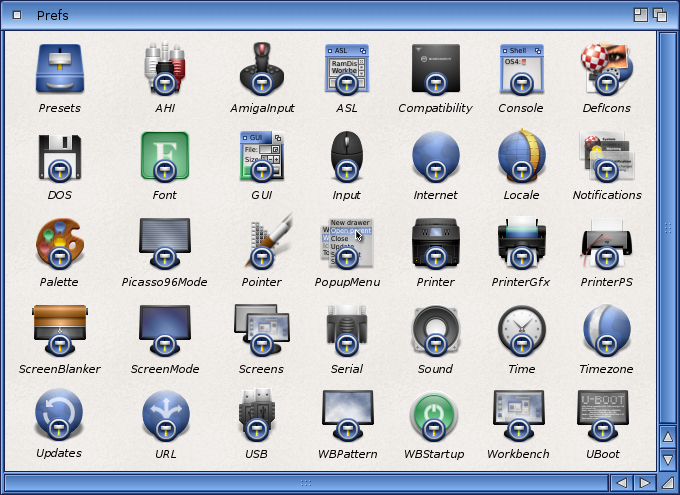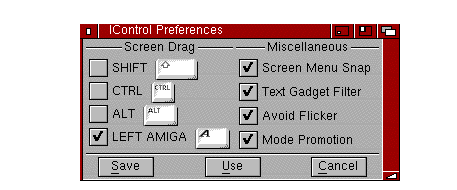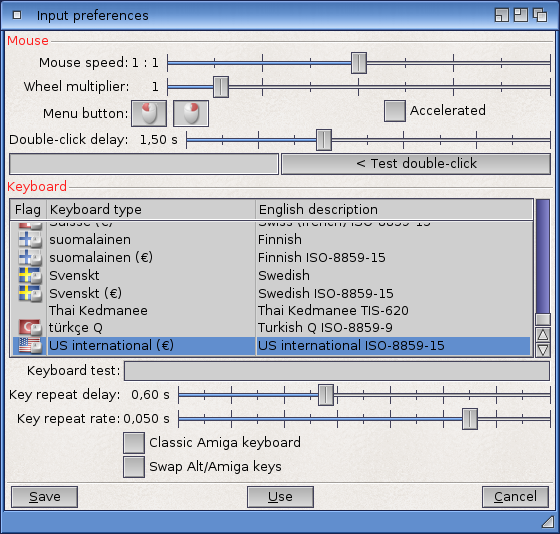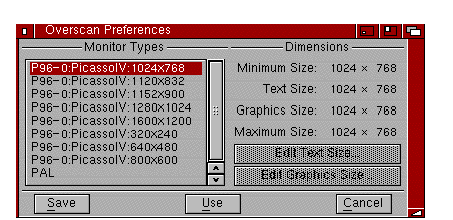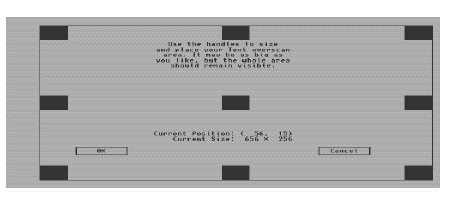Copyright (c) Hyperion Entertainment and contributors.
Difference between revisions of "AmigaOS Manual: Workbench Preferences"
Steven Solie (talk | contribs) |
Steven Solie (talk | contribs) |
||
| Line 288: | Line 288: | ||
When you change the overscan values for a particular monitor type, all modes within that type are affected. To change the overscan values for a monitor type, select its monitor type from the scrolling list. The selected group is highlighted. See Chapter 7 for listings of the maximum available overscan sizes for each display mode. |
When you change the overscan values for a particular monitor type, all modes within that type are affected. To change the overscan values for a monitor type, select its monitor type from the scrolling list. The selected group is highlighted. See Chapter 7 for listings of the maximum available overscan sizes for each display mode. |
||
| + | |||
| + | === Text and Graphics Overscan === |
||
| + | |||
| + | The Overscan editor allows you to set two different types of overscan: Text and Graphics. Most users can ignore the difference and set both to the same maximum value appropriate for their monitor. Having two settings can help those who use a television set as a monitor or whose monitor is unable to display a sharp image across its entire width. |
||
| + | |||
| + | The screen size and position set as Text overscan is the setting used by the Workbench screen. It can be any size between the minimum and maximum Dimensions limits, but it cannot be any larger than the Graphics overscan setting. If it is enlarged beyond the current Graphics setting, the Graphics setting is adjusted to match. |
||
| + | |||
| + | The screen size and position set as Graphics overscan are the limits within which the Text overscan area must fit and is the maximum for application screens in that display group. Graphics overscan can be any size between the minimum and maximum Dimensions limits. If the Graphics overscan area is sized or moved, the current Text overscan setting is adjusted as necessary to fit. |
||
| + | |||
| + | === Using Different Text and Graphics Overscan === |
||
| + | |||
| + | A television image normally extends beyond the edges of the screen itself, so that the outermost edges of the image are not visible. If some part of the Amiga's display runs off the edges of the screen on your television set or monitor or is distorted at the edges, use different Text and Graphics overscan settings. |
||
| + | |||
| + | Confine the Workbench and application screens that must remain legible to the visible area by setting Text overscan to the minimum size and centering it on the screen. The Graphics overscan area can be larger, allowing graphic images and other material for which legibility is less important to fill more of the monitor screen. |
||
| + | |||
| + | === Overscan Edit Screens === |
||
| + | |||
| + | Selecting either the Edit Text Size or Edit Graphics Size gadgets displays a separate screen, illustrated in Figure 5-5, on which you graphically adjust the overscan size. The Overscan editor allows you to set two different overscan regions. |
||
| + | |||
| + | [[File:WorkbenchFig5-5.png|frame|center|Edit Text Size Window]] |
||
| + | |||
| + | The black rectangles on the screen are handles and the line connecting the handles represents the outermost area where the Amiga's output can be displayed. Enlarge the display area by pointing to a handle, holding down the selection button, and dragging the handle to the edge of the screen. Only the active handle is visible on the screen when you drag it. |
||
| + | |||
| + | Moving any part of the handle off the screen or out of the viewing area over enlarges it, losing a portion of the visible image. |
||
| + | |||
| + | For monitor types other than NTSC and PAL, there are four arrow gadgets in the lower left area of the edit screen. The arrow gadgets allow you to shift the entire display area up, down, right, and left to center it. Move the display in the direction of the arrows by clicking on them. Depending on your monitor type, it is possible to move the display too far to the right or left, causing the monitor to go out of sync. This can result in the colors fading or a total disruption of the display. Because this condition can damage you monitor, it is important not to leave it this way for an period of time. If this happens, you can use the arrow keys on the keyboard to move the display back into position or press the Escape key, which undoes any changes you made and returns to the Overscan editor window. |
||
| + | |||
| + | Use the center handle to position the display area within the viewable area when the screen is not at maximum size. By dragging the handle, you can shift the display area in any direction to center it on your monitor screen. |
||
| + | |||
| + | The Current Position figures show the x/y distance in pixels from the upper left corner of the screen to the upper left corner of the display area. Current Size shows the size of the viewable area defined by the handles. |
||
| + | |||
| + | To accept changes and return to the Overscan editor, select OK. To exit the screen without accepting any changes and return to the Overscan editor, select Cancel or press the Escape key. |
||
| + | |||
| + | === Dimensions === |
||
| + | |||
| + | The different sizes of the overscan areas are displayed on the right of the Overscan window. The sizes are given in number of pixels, representing the width and the height of the screen. |
||
| + | |||
| + | For PAL or NTSC groups, the sizes correspond to the sizes for a standard High Res screen. If Multiscan is selected, the sizes for a non-interlaced Productivity screen are given. All other display modes in a group are affected proportionally. |
||
| + | |||
| + | The size categories are: |
||
| + | |||
| + | {| class="wikitable" |
||
| + | | Minimum || The standard, non-overscan size of a screen. |
||
| + | |- |
||
| + | | Text || The current Text Overscan size. |
||
| + | |- |
||
| + | | Graphics || The current Graphics Overscan size. |
||
| + | |- |
||
| + | | Maximum || Maximum allowable overscan size, Text or Graphics. |
||
| + | |} |
||
Revision as of 00:41, 12 February 2014
This chapter explains the Preferences editors found in the Prefs drawer. These editors allow you to customize your Amiga environment by:
- Choosing a keyboard type
- Setting your preferred language
- Changing the Workbench screen display
- Changing the Workbench colors
- Changing the shape of the pointer
- Specifying a printer and setting it up for output
- Setting up a modem for use with the Amiga
- Setting the time and date
This chapter contains the following Preferences editor information:
- Contents of the Prefs drawer
- Editor menus
- Presets drawer
- Descriptions of each Preferences editor
Contents
Prefs Drawer
The Prefs drawer contains the icons for the Preferences editors and the Preset drawer. Figure 5-1 illustrates the Preferences editors window.
The following editors are listed in the order in which they are described in this chapter:
| Font | For changing the fonts used in the different areas of the screen. |
| IControl | For choosing miscellaneous system options, such as the key used for screen drag. |
| Input | For changing the mouse speeds, key repeat speeds, and selecting keyboard type. |
| Locale | For selecting the language and locality. |
| Overscan | For adjusting the size of the display area for text and for graphics. |
| Palette | For changing the Workbench colors. |
| Pointer | For changing the size, shape, and color of the mouse pointer and busy pointer. |
| Printer | For specifying the printer driver that matches your printer and for specifying options, such as paper size and margin width. |
| PrinterGfx | For setting up your printer to print graphics. |
| PrinterPS | For controlling output to a PostScript printer. |
| ScreenMode | For choosing a different monitor display mode. |
| Serial | For setting the specifications for the serial port, which is used to communicate through modems or networking systems. |
| Sound | For determining the sound your Amiga produces for its display beep. |
| Time | For setting the time and date. |
| WBPattern | For selecting or creating background patterns for the Workbench windows and screen. |
| Presets | For storing different Preferences editor configurations changed through the Project menu. |
Editor Menus and Presets Drawer
With the exception of Time, each editor has three menus: Project, Edit, and Settings. The Project menu lets you save and load Prefs preset files, which allow you to quickly change to different configurations. By default, these files are saved in the Presets drawer (SYS:Prefs/Presets), although they can be saved to any location you specify. If you save icons for the files (by selecting Create Icons?), you can activate the settings by opening the file's icon, rather than opening the actual editor.
When you save settings in the Preferences editors by clicking on the Save button, the system stores those settings in the following location:
SYS:Prefs/ENV-Archive/Sys/editorx.prefs
where SYS: is the name of the volume containing the file and editorx is the name of the specific Preferences editor. The settings saved to the Env-Archive drawer are the ones used when you boot. We recommend when you use the Save As option that you use the path provided or a completely different path than this for storing Preset files.
Project Menu
The following Project menu options let you save the editor settings to a specific file and open previously saved files:
| Open | Loads the information from a specified preset file. |
| Save As | Specify the preset file in which to save the currently displayed settings. The requester provides a default file name in the Presets drawer. Change this to a different name if you have more than one preset for that editor. |
| Quit | Exits the editor without performing any changes. The same as Cancel gadget. |
Edit Menu
The Edit menu options allow you to restore previously used settings or the default settings. The options are:
| Reset to Defaults | Returns the editor settings to the system default settings. |
| Last Saved | Returns the editor settings to the last settings you saved with the Save gadget (not the Save As item). |
| Restore | Returns the editor to the settings displayed when you opened the editor first. |
The WBPattern and Pointer Edit Menus have the following additional options:
| Cut | Copies and clears the whole work area to the Clipboard. |
| Copy | Copies the whole work area to the Clipboard. |
| Paste | Replaces the whole work area with the last thing cut or copied. |
| Erase | Deletes everything in the work area. |
| Undo | Undoes the last action performed. |
| Load Image | Opens a file requester for entering the name of an image file to use as a background pattern or picture. |
These options make editing patterns and pointer images easier. Use Cut, Copy, and Paste to transfer images between the editor and a Clipboard-aware program with more extensive drawing tools, such as IconEdit. Use Load Image to import any standard IFF bitmap image into the editor. (Images larger than the editor work area are cut off on the bottom and right sides when loaded or pasted.)
Settings Menu
The Settings menu contains the Create Icons? Item that allows you to save project icons for the preset files. For example, if you save printer specifications to the SYS:Prefs/Presets/Printer.pre file, an icon for the file appears in the Presets window. Double-click on the icon to activate the file's settings.
Using the Presets Drawer
Open the Presets drawer and double-click on an Presets Project icon to use its settings. Or open the editor, choose the Open menu item, and use the Load requester to select the preset. Select Use to use the settings until you reboot or open another editor file.
Font Editor
The Font editor changes fonts used on the Amiga.
For information on fonts and on using the Font Preferences editor, see Chapter 8.
IControl Editor
The IControl editor, illustrated in Figure 5-2, lets you change system settings, such as the screen drag qualifier key and the text gadget filter.
Screen Drag
The Screen Drag gadget specifies other keys that can be used in addition to, or in place of, the left Amiga key as the qualifier for dragging the Workbench screen. This is useful if, for example, an application uses left Amiga and the selection button for other functions.
The available keys are Shift, Ctrl, left Amiga, and Alt. To select a key, click on its check box.
If you select Ctrl, you must hold down Ctrl to drag the screen. If Ctrl and Shift are selected, you must hold down both Ctrl and Shift to drag the screen.
Screen Menu Snap
Screen Menu Snap is provided for users who work with screens that are larger than the monitor's display area. Normally the Workbench menus appear at the top left corner of the screen. If the left-most side of the screen is not visible, Screen Menu Snap shifts the Workbench screen so that the menus are still accessible. The screen shifts only while the menu button is held down.
Text Gadget Filter
The Text Gadget Filter affects whether control characters function as characters or as editing commands when entered into text gadgets. A control character is a key combination (usually Ctrl and an alphabetical key) that normally performs a certain function.
The standard control characters for text entry are:
| Ctrl+M | Same as pressing Return. |
| Ctrl+H | Deletes one character to the left of the cursor (same as Backspace). |
| Ctrl+X | Deletes the entire line. |
| Ctrl+U | Deletes all characters to the left of the cursor. |
| Ctrl+K | Deletes all characters from the cursor to the end of the line. |
| Left Arrow | Moves the cursor one character to the left. |
| Right Arrow | Moves the cursor one character to the right. |
| Ctrl+A | Moves the cursor to the beginning of the line. |
| Ctrl+Z | Moves the cursor to the end of the line. |
When Text Gadget Filter is selected, entering one of these control characters when the cursor is in a non-numeric text gadget has the function indicated above. When the filtering is off, the control character is included in the string entered; on the screen the control characters appear as an open box or other nonstandard character.
You can insert control characters into the text gadget whether filtering is turned on or not by pressing Ctrl+left Amiga along with the desired alphabetical key. For example, to enter Ctrl+M into the text gadget, press Ctrl+left Amiga+M.
| Note |
|---|
| In certain windows with several text gadgets, pressing Tab moves the cursor to the next text gadget. In these windows, even if the Text gadget filter is off, you must still press left Amiga+Tab to enter a Tab into the gadget. |
Avoid Flicker
The Avoid Flicker option prevents a back screen from becoming interlaced when the front screen is pulled down to reveal it. The default for this option is on.
Mode Promotion
The Mode Promotion gadget controls the software de-interlacing feature of Amigas with the AGA chip set. Selecting Mode Promotion allows NTSC and PAL screens opened by applications to be promoted to a non-flickering display mode. We recommend that you turn this option off when doing video work. For more information about Mode Promotion, see Chapter 7.
Input Editor
The Input editor allows you to change the speed at which the mouse and keyboard operate and to select your keyboard type. Figure 5-3 illustrates the Input-Preferences editor window.
Mouse Speed
The Mouse Speed slider determines how fast the mouse pointer moves across the screen relative to mouse movement. The faster the pointer moves across the screen, the less surface space and effort is needed to move the mouse.
Choose from three mouse pointer speeds: 1, 2, and 3, where 1 is the slowest and 3 is the fastest. Set the mouse pointer speed by dragging the slider bar until the desired value is displayed. The mouse speed takes effect while you set it, allowing you to try each speed without exiting the editor. The default value is 3.
Acceleration
The Acceleration feature is used for moving the pointer quickly over large screen areas while retaining fine control for smaller movements. If acceleration is on, the pointer speed remains constant within a small area. However, as the pointer is moved further across the screen, its speed increases, moving it quickly over a large area of the screen.
Select the check box to turn acceleration on or off. The default value is off.
Double-Click Delay
The Double-Click Delay slider determines how fast you click the selection button to register a double-click.
The range is from 1 to 200, with 1 being the least delay. The Show Double-Click gadget shows the amount of time for the selected value by displaying shading in the gadget for the length of the delay. The default value is 75, which allows approximately one second between clicks.
Test your chosen speed by double-clicking in the Test Double-Click gadget. When the double-click takes place within the allotted time, a Double-Clicked message appears next to the gadget; if not, a Too Slow message appears.
Key Repeat Delay
Most of the keys on the keyboard automatically repeat when held down. Change the delay that occurs before the key repeats with the Key Repeat Delay slider.
The current setting is shown next to the slider. The range is from 1 to 75, with 1 being the least delay. Drag the slider bar to the right to increase the delay and to the left to decrease it. The default value is 30.
Key Repeat Rate
The Key Repeat Rate slider determines the rate at which the keys repeat after the initial key repeat delay.
The range is from 1 to 125, where 1 is the slowest. Drag the slider bar to the right to increase the speed and to the left to decrease it. The default value is 100.
Keyboard Test
The Keyboard Test gadget allows you to test the settings chosen for the key repeat delay, the key repeat rate, and the keyboard type.
Select the gadget and hold down one of the alphabetic keys on the keyboard. The Keyboard Test gadget shows the character for that key in the selected keyboard type, repeating according to the current key delay and key repeat rate.
Keyboard Type
The Keyboard Type list lets you select the appropriate keyboard type for your localized system. The correct keyboard type matches the characters printed on your keyboard's keys and gives you quick access to the special characters that are part of your language and locale. If you are using a keyboard other than USA, you can use dead keys to produce accented characters. See the KeyShow description in Chapter 10 for dead key information.
| Note |
|---|
| If your keyboard type is not the default American, you must activate your appropriate keymap/keyboard. Consult your dealer if you are not sure which keymap/keyboard you should use. |
Choosing a particular keyboard type activates the corresponding keymap file in the Devs/Keymaps drawer. Select your keyboard type in the Input Preferences editor by clicking on it.
The available keymaps and the corresponding keyboards are:
| Keymap | Keyboard Type |
|---|---|
| gb | British |
| cdn | Canadien Français |
| dk | Dansk |
| d | Deutsch |
| usa2 | Dvorak |
| e | Español |
| f | Français |
| i | Italiana |
| n | Norsk |
| po | Português |
| ch2 | Schweiz |
| ch1 | Suisse |
| s | Svenskt |
If your keyboard type does not appear in the Keyboard Type list, it means that the corresponding keymap is not present in the Devs/Keymaps drawer. Install the corresponding keymap to correct this using the following steps:
- Insert either the Storage floppy disk or the disk containing the Storage drawer in any drive.
- Open the Storage window and then open the Keymaps drawer.
- Drag the correct icon into the Devs/Keymaps drawer.
Then this is complete, you can return to the Input Preferences editor to activate your keyboard type. To check your keyboard layout, use the KeyShow program in the Tools drawer. For more information about KeyShow, see Chapter 10.
Locale Editor
The Locale editor lets you choose the languages with which you interact with the Amiga. The default setting is USA English; however, you can use the Locale editor to choose another language. See Chapter 6 for a full description of the Locale editor.
Overscan Editor
The Overscan editor, illustrated in Figure 5-4, enlarges the size of your screen to use the extra space normally unused around the edges of the monitor screen, known as the overscan area.
The Monitor Types available reflect the monitor drivers that are currently active. Monitor files that are in DEVS:Monitors when you boot are automatically activated. Each monitor type controls a set of display modes, called a display group.
When you change the overscan values for a particular monitor type, all modes within that type are affected. To change the overscan values for a monitor type, select its monitor type from the scrolling list. The selected group is highlighted. See Chapter 7 for listings of the maximum available overscan sizes for each display mode.
Text and Graphics Overscan
The Overscan editor allows you to set two different types of overscan: Text and Graphics. Most users can ignore the difference and set both to the same maximum value appropriate for their monitor. Having two settings can help those who use a television set as a monitor or whose monitor is unable to display a sharp image across its entire width.
The screen size and position set as Text overscan is the setting used by the Workbench screen. It can be any size between the minimum and maximum Dimensions limits, but it cannot be any larger than the Graphics overscan setting. If it is enlarged beyond the current Graphics setting, the Graphics setting is adjusted to match.
The screen size and position set as Graphics overscan are the limits within which the Text overscan area must fit and is the maximum for application screens in that display group. Graphics overscan can be any size between the minimum and maximum Dimensions limits. If the Graphics overscan area is sized or moved, the current Text overscan setting is adjusted as necessary to fit.
Using Different Text and Graphics Overscan
A television image normally extends beyond the edges of the screen itself, so that the outermost edges of the image are not visible. If some part of the Amiga's display runs off the edges of the screen on your television set or monitor or is distorted at the edges, use different Text and Graphics overscan settings.
Confine the Workbench and application screens that must remain legible to the visible area by setting Text overscan to the minimum size and centering it on the screen. The Graphics overscan area can be larger, allowing graphic images and other material for which legibility is less important to fill more of the monitor screen.
Overscan Edit Screens
Selecting either the Edit Text Size or Edit Graphics Size gadgets displays a separate screen, illustrated in Figure 5-5, on which you graphically adjust the overscan size. The Overscan editor allows you to set two different overscan regions.
The black rectangles on the screen are handles and the line connecting the handles represents the outermost area where the Amiga's output can be displayed. Enlarge the display area by pointing to a handle, holding down the selection button, and dragging the handle to the edge of the screen. Only the active handle is visible on the screen when you drag it.
Moving any part of the handle off the screen or out of the viewing area over enlarges it, losing a portion of the visible image.
For monitor types other than NTSC and PAL, there are four arrow gadgets in the lower left area of the edit screen. The arrow gadgets allow you to shift the entire display area up, down, right, and left to center it. Move the display in the direction of the arrows by clicking on them. Depending on your monitor type, it is possible to move the display too far to the right or left, causing the monitor to go out of sync. This can result in the colors fading or a total disruption of the display. Because this condition can damage you monitor, it is important not to leave it this way for an period of time. If this happens, you can use the arrow keys on the keyboard to move the display back into position or press the Escape key, which undoes any changes you made and returns to the Overscan editor window.
Use the center handle to position the display area within the viewable area when the screen is not at maximum size. By dragging the handle, you can shift the display area in any direction to center it on your monitor screen.
The Current Position figures show the x/y distance in pixels from the upper left corner of the screen to the upper left corner of the display area. Current Size shows the size of the viewable area defined by the handles.
To accept changes and return to the Overscan editor, select OK. To exit the screen without accepting any changes and return to the Overscan editor, select Cancel or press the Escape key.
Dimensions
The different sizes of the overscan areas are displayed on the right of the Overscan window. The sizes are given in number of pixels, representing the width and the height of the screen.
For PAL or NTSC groups, the sizes correspond to the sizes for a standard High Res screen. If Multiscan is selected, the sizes for a non-interlaced Productivity screen are given. All other display modes in a group are affected proportionally.
The size categories are:
| Minimum | The standard, non-overscan size of a screen. |
| Text | The current Text Overscan size. |
| Graphics | The current Graphics Overscan size. |
| Maximum | Maximum allowable overscan size, Text or Graphics. |
